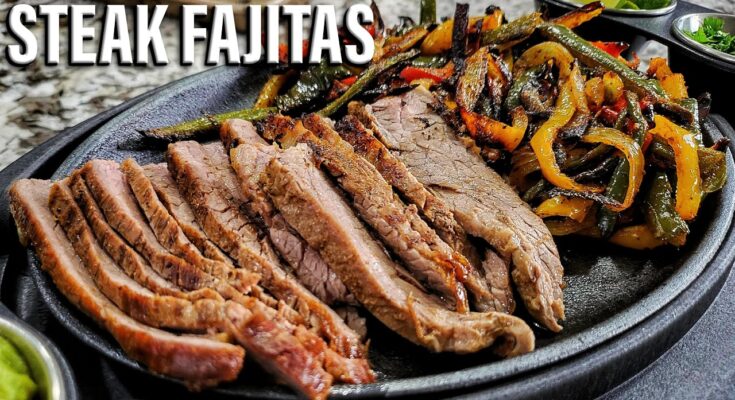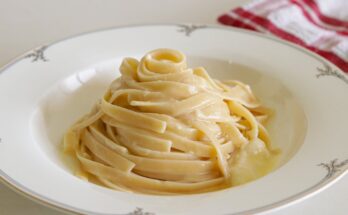Steak Fajitas Recipe: Steak fajitas are a delicious and vibrant Tex-Mex dish, perfect for family dinners, gatherings, or even meal prepping. With their sizzling aroma, tender steak, and fresh vegetables, they’re a crowd-pleaser that’s easier to make than you might think.
Follow this step-by-step guide to create restaurant-quality steak fajitas in the comfort of your kitchen.
What Are Steak Fajitas?
Steak fajitas are a popular Mexican-inspired dish made with marinated grilled steak, sautéed vegetables, and warm tortillas. The word “fajitas” comes from the Spanish word “faja,” meaning “strip” or “belt,” referencing the thinly sliced strips of steak traditionally used in this dish.
Why Are Steak Fajitas So Popular?
The sizzling platter of fajitas, often served with vibrant peppers, onions, and your choice of toppings, is as much a visual treat as it is a culinary delight. They’re quick to prepare, customizable for various dietary needs, and pack a punch of bold flavors that keep you coming back for more.
Ingredients for Steak Fajitas
Essential Ingredients for the Marinade
The marinade is the key to tender, flavorful steak. Here’s what you’ll need:
- Fresh lime juice (2-3 limes)
- Olive oil (2 tablespoons)
- Soy sauce (2 tablespoons)
- Garlic (3 cloves, minced)
- Chili powder (1 teaspoon)
- Cumin (1 teaspoon)
- Paprika (1 teaspoon)
- Honey or brown sugar (1 tablespoon)
- Salt and black pepper (to taste)
Vegetables and Seasonings for Perfect Fajitas
- Bell peppers (3, assorted colors)
- Red onion (1 large)
- Jalapeño (optional, for heat)
- Salt, pepper, and a dash of oregano
Tortilla Selection – Flour or Corn?
Both flour and corn tortillas work well for fajitas. Flour tortillas are softer and more pliable, while corn tortillas offer an authentic, earthy flavor. Choose based on your personal preference!
Equipment Needed for Making Steak Fajitas
The Best Cooking Tools for Fajitas
To make fajitas, you’ll need:
- A large skillet or cast-iron pan
- Tongs for flipping the steak
- Sharp knife for slicing
Choosing the Right Skillet or Grill
A cast-iron skillet is highly recommended because it holds heat well, giving the steak and vegetables the perfect char. Alternatively, you can use a grill for a smokier flavor.
Preparing the Marinade
Step 1: Mixing the Ingredients
In a medium bowl, whisk together lime juice, olive oil, soy sauce, garlic, chili powder, cumin, paprika, honey, salt, and pepper. Make sure everything is evenly combined for a balanced flavor.
Step 2: Marinating the Steak
Place the steak (flank steak, skirt steak, or sirloin) into a zip-top bag or shallow dish. Pour the marinade over the steak, ensuring it’s fully coated. Seal the bag or cover the dish, then refrigerate for at least 2 hours, but ideally overnight for maximum flavor absorption.
Preparing the Vegetables
Best Way to Slice Bell Peppers and Onions
Cut the bell peppers and onions into thin, uniform slices to ensure even cooking. Removing the seeds from the peppers will keep the dish mild, but you can leave them in for extra spice.
Keeping the Vegetables Crisp and Flavorful
To preserve their vibrant color and slight crunch, avoid overcooking the vegetables. A quick sauté over high heat works best.
Cooking the Steak
Step 1: Heating the Skillet or Grill
Preheat your skillet or grill to high heat. A hot surface is essential for searing the steak and locking in the juices.
Step 2: Cooking the Steak to Perfection
Place the steak on the hot skillet or grill and cook for 4-5 minutes per side, depending on your preferred doneness. Use a meat thermometer for accuracy (130°F for medium-rare, 140°F for medium). Let the steak rest for 5-10 minutes before slicing it thinly against the grain.
Cooking the Vegetables
Getting the Right Char on Bell Peppers and Onions
After removing the steak from the skillet or grill, it’s time to cook the vegetables. Add a splash of olive oil to the skillet if needed, and toss in the sliced bell peppers and onions. Cook over medium-high heat, stirring occasionally, until they develop a slight char and soften—this usually takes about 5-7 minutes. The goal is to maintain a balance of tenderness and crunch.
Blending Vegetables with Steak Juices
For an added burst of flavor, scrape up any browned bits from the pan left behind by the steak and mix them into the vegetables. These bits, also called fond, are packed with savory goodness and tie the dish together beautifully.
Assembling Your Steak Fajitas
Warming the Tortillas
Warm tortillas make all the difference. You can heat them in a dry skillet for about 30 seconds on each side or wrap them in foil and place them in a warm oven for a few minutes. Alternatively, microwave the tortillas wrapped in a damp paper towel for 20-30 seconds.
Adding the Filling
Start with a layer of the sizzling vegetables on each tortilla, followed by thin slices of the perfectly cooked steak. Keep the portions manageable to make wrapping easier and less messy.
Toppings and Condiments to Consider
Top your fajitas with any of these delicious options:
- Fresh salsa or pico de gallo
- Guacamole or sliced avocado
- Sour cream or Greek yogurt
- Shredded cheese (cheddar, Monterey Jack, or queso fresco)
- Fresh cilantro and lime wedges for garnish
Serving and Presentation Tips
How to Serve Fajitas Family-Style
For a fun and interactive meal, serve everything on a large platter: the steak slices, sautéed vegetables, warm tortillas, and all the toppings. Let everyone customize their fajitas to their liking. This approach makes the meal feel festive and encourages creativity.
Garnishing for a Mouthwatering Look
Sprinkle some freshly chopped cilantro over the assembled fajitas, and serve with lime wedges for an extra pop of color and flavor. Arrange everything neatly on the platter to create a visually appealing presentation.
Tips for Making the Best Steak Fajitas
Avoiding Common Mistakes
- Don’t skip the marinade: It’s essential for tender, flavorful steak.
- Preheat your skillet or grill properly: A hot cooking surface ensures a good sear.
- Slice against the grain: Cutting the steak this way ensures tender bites.
Adjusting the Recipe for Dietary Preferences
- Use gluten-free tortillas for a gluten-free option.
- Swap out the steak for portobello mushrooms, tofu, or shrimp for a vegetarian or pescatarian version.
- Add extra vegetables like zucchini or cherry tomatoes for a more nutrient-packed dish.
Storing and Reheating Leftovers
How to Store Cooked Steak and Vegetables
Place any leftover steak and vegetables in separate airtight containers. Store them in the refrigerator for up to 3-4 days. Keep the tortillas sealed in their original packaging or a zip-top bag to prevent them from drying out.
Best Methods to Reheat for Freshness
- For the steak: Reheat in a skillet over medium heat for 1-2 minutes, or microwave it in short intervals to avoid overcooking.
- For the vegetables: Sauté them in a hot skillet to restore their charred texture.
- For tortillas: Reheat in a dry skillet or microwave as described earlier.
FAQs about Steak Fajitas Recipe
1. What kind of steak is best for fajitas?
The best steak for fajitas is typically skirt steak or flank steak. These cuts are flavorful and, when cooked properly, offer a great balance of tenderness and texture ideal for the quick searing that fajitas require.
2. How should I season steak fajitas?
For authentic flavor, season your steak with a mixture of chili powder, cumin, garlic powder, onion powder, salt, and pepper. You can also marinate the steak in lime juice and cilantro for added zest.
3. How long should I cook steak fajitas?
Steak fajitas cook quickly due to the thin slicing of the meat. Generally, searing the steak for about 3-4 minutes on each side over high heat should suffice. The goal is to achieve a slightly charred exterior while keeping the inside juicy.
4. What vegetables go well in steak fajitas?
Typical vegetables include bell peppers and onions. Sliced thinly, these vegetables can be sautéed in the same pan used for the steak, picking up all the flavorful bits left behind.
5. Can I make steak fajitas ahead of time?
Yes, you can prepare the components of steak fajitas ahead of time. Cook the steak and vegetables, then refrigerate them. Reheat when ready to serve for a quick and convenient meal.
6. What sides pair well with steak fajitas?
Popular side dishes for steak fajitas include rice, beans, guacamole, sour cream, and a fresh salsa. These add variety and freshness to balance the hearty flavors of the fajitas.
7. Are steak fajitas gluten-free?
Steak fajitas can be gluten-free, depending on the tortillas and seasonings used. Always check labels to ensure they do not contain gluten ingredients if you’re aiming for a gluten-free meal.
8. How can I make my fajitas spicy?
To add a spicy kick to your fajitas, include chopped jalapeños or increase the amount of chili powder in your seasoning. Another option is to serve with a spicy salsa or hot sauce.
Conclusion
Steak fajitas are a classic dish that combines bold flavors, fresh ingredients, and a bit of creativity in the kitchen. Whether you’re serving them for a family dinner or a casual get-together, this recipe is guaranteed to impress. The combination of tender steak, vibrant vegetables, and warm tortillas is comfort food at its best. With this step-by-step guide, you’re all set to create a sizzling masterpiece that will have everyone asking for seconds.



